
North Adams is a city in Berkshire County, Massachusetts, United States. It is part of the Pittsfield, Massachusetts Metropolitan Statistical Area. Its population was 12,961 as of the 2020 census. Best known as the home of the largest contemporary art museum in the United States, the Massachusetts Museum of Contemporary Art, North Adams has in recent years become a center for tourism, culture and recreation.

King George's War (1744–1748) is the name given to the military operations in North America that formed part of the War of the Austrian Succession (1740–1748). It was the third of the four French and Indian Wars. It took place primarily in the British provinces of New York, Massachusetts Bay, New Hampshire, and Nova Scotia. Its most significant action was an expedition organized by Massachusetts Governor William Shirley that besieged and ultimately captured the French fortress of Louisbourg, on Cape Breton Island in Nova Scotia, in 1745. In French, it is known as the Troisième Guerre Intercoloniale or Third Intercolonial War.

Williamstown is a town in Berkshire County, Massachusetts, United States. It shares a border with Vermont to the north and New York to the west. Located in Berkshire County, the town is part of the Pittsfield, Massachusetts metropolitan statistical area. The population was 7,513 at the 2020 census. A college town, it is home to Williams College, the Clark Art Institute and the Tony-awarded Williamstown Theatre Festival.

King Philip's War was an armed conflict in 1675–1676 between a group of indigenous peoples of the Northeastern Woodlands and the English New England Colonies and their indigenous allies. The war is named for Metacomet, the Pokanoket chief and sachem of the Wampanoag who adopted the English name Philip because of the friendly relations between his father Massasoit and the Plymouth Colony. The war continued in the most northern reaches of New England until the signing of the Treaty of Casco Bay on April 12, 1678.

The capture of Fort Ticonderoga occurred during the American Revolutionary War on May 10, 1775, when a small force of Green Mountain Boys led by Ethan Allen and Colonel Benedict Arnold surprised and captured the fort's small British garrison. The cannons and other armaments at Fort Ticonderoga were later transported to Boston by Colonel Henry Knox in the noble train of artillery and used to fortify Dorchester Heights and break the standoff at the siege of Boston.
Ephraim Williams Jr. was a soldier and land owner from the Province of Massachusetts Bay who was killed in the French and Indian War. He was the benefactor of Williams College, located in northwestern Massachusetts. The school's athletic programs, the Ephs, are named after Williams.

Dummer's War (1722–1725) was a series of battles between the New England Colonies and the Wabanaki Confederacy, who were allied with New France. The eastern theater of the war was located primarily along the border between New England and Acadia in Maine, as well as in Nova Scotia; the western theater was located in northern Massachusetts and Vermont at the border between Canada and New England. During this time, Maine and Vermont were part of Massachusetts.

The Raid on Deerfield, also known as the Deerfield Massacre, occurred during Queen Anne's War on February 29, 1704, when French and Native American raiders under the command of Jean-Baptiste Hertel de Rouville attacked the English colonial settlement of Deerfield, Massachusetts Bay, just before dawn. They burned parts of the town and killed 47 colonists. The raiders left with 112 colonists as captives, whom they took overland the nearly 300 miles to Montreal; some died or were killed along the way because they were unable to keep up. Roughly 60 colonists were later ransomed by their associates, while others were adopted by Mohawk families at Kahnawake and became assimilated into the tribe. In this period, English colonists and their Indian allies were involved in similar raids against French villages along the northern area between the spheres of influence.

Jonathan Eddy was a British-American soldier, who fought for the British in the French and Indian War and for the Americans in the American Revolution. After the French and Indian War, he settled in Nova Scotia as a New England Planter, becoming a member of the General Assembly of Nova Scotia. During the American Revolutionary War, he was strongly supportive of the rebellion against the Crown. He encouraged the residents of Nova Scotia to join in open revolt against King George III and England. He led a failed attempt to capture Fort Cumberland in 1776 and was forced to retreat to Massachusetts, the place of his birth. The following year, he led the defense of Machias, Maine during the Battle of Machias (1777). After the war, he established the community now known as Eddington, Maine in 1784, where he died.
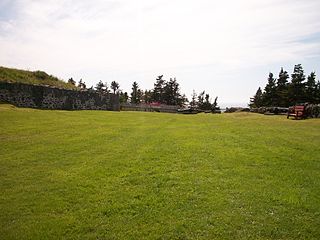
Castle Hill is an area containing the remains of both French and British fortifications, overlooking the town of Placentia in Newfoundland and Labrador, Canada. The site was originally established in order to protect the French fishing interests in Terre-Neuve (Newfoundland) and the approaches to the French colony of Canada.
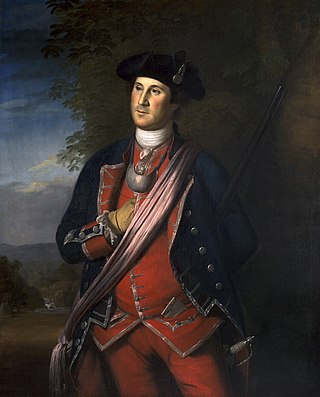
Colonial American military history is the military record of the Thirteen Colonies from their founding to the American Revolution in 1775.
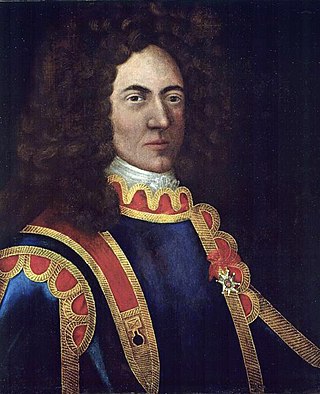
The Raid on Haverhill was a military engagement that took place on August 29, 1708, during Queen Anne's War. French, Algonquin, and Abenaki warriors under the command of Jean-Baptiste Hertel de Rouville descended on Haverhill, then a small frontier community in the Province of Massachusetts Bay. In the surprise attack, 16 people were killed and another 14 to 24 were taken captive. A rapid militia muster gave chase, and in a skirmish later in the day, nine of the French and Indian party were killed and some of their prisoners escaped.
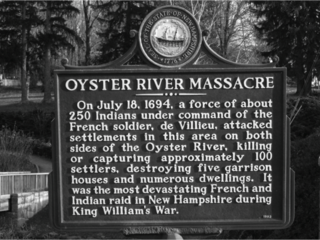
The Raid on Oyster River happened during King William's War, on July 18, 1694, at present-day Durham, New Hampshire.
The siege of Fort Massachusetts was a successful siege of Fort Massachusetts by a mixed force of more than 1,000 French and Native Americans from New France. The fort, garrisoned by a disease-weakened militia force from the Province of Massachusetts Bay, surrendered after its supplies of ammunition and gunpowder were depleted. Thirty prisoners were taken and transported back to Quebec, where about half of them died in captivity.

The Sudbury Fight was a battle of King Philip's War, fought in what is today Sudbury and Wayland, Massachusetts, when approximately five hundred Wampanoag, Nipmuc, and Narragansett Native Americans raided the frontier settlement of Sudbury in Massachusetts Bay Colony. Disparate companies of English militiamen from nearby settlements marched to the town's defense, two of which were drawn into Native ambushes and suffered heavy losses. The battle was the last major Native American victory in King Philip's War before their final defeat in southern New England in August 1676.

The Battle of Norridgewock was a raid on the Abenaki settlement of Norridgewock by a group of colonial militiamen from the New England Colonies. Occurring in contested lands on the edge of the American frontier, the raid resulted in a massacre of the Abenaki inhabitants of Norridgewock by the militiamen.
The Northeast Coast campaign was the first major campaign by the French of Queen Anne's War in New England. Alexandre Leneuf de La Vallière de Beaubassin led 500 troops made up of French colonial forces and the Wabanaki Confederacy of Acadia. They attacked English settlements on the coast of present-day Maine between Wells and Casco Bay, burning more than 15 leagues of New England country and killing or capturing more than 150 people. The English colonists protected some of their settlements, but a number of others were destroyed and abandoned. Historian Samuel Drake reported that, "Maine had nearly received her death-blow" as a result of the campaign.

Benjamin Simonds was a militia commander of Massachusetts during the French and Indian War and the American Revolutionary War. He was colonel of the all-Berkshire regiment of about five hundred men known as the “Berkshire Boys” during the American Revolutionary War. His regiment, the 2nd Berkshire County Regiment, notably fought in the Battle of Bennington in the summer of 1777.
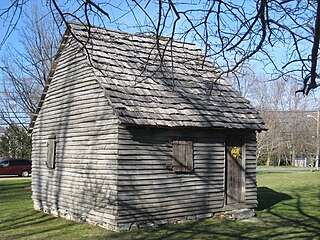
The 1753 House is a historical replica of a regulation settler's home in The Berkshires in 1753. Located in Field Park at the west end of Williamstown, Massachusetts, in the center of the roundabout at the intersection of Massachusetts Route 2 and United States Route 7, the house was constructed by volunteers in 1953 in celebration of the town's Bicentennial. Early settlers to the Hoosac Valley, the area now occupied by towns such as Williamstown and North Adams, were required by legal contract to build a house at least 15 by 18 feet and 7 feet high and to clear 5 acres of land to gain a title to their lot.

Provincial troops were military units raised by colonial governors and legislatures in British North America for extended operations during the French and Indian Wars. The provincial troops differed from the militia, in that they were a full-time military organization conducting extended operations. They differed from the regular British Army in that they were recruited only for one campaign season at the time. These forces were often recruited through a quota system applied to the militia. Officers were appointed by the provincial governments. During the eighteenth century militia service was increasingly seen as a prerogative of the social and economic well-established, while provincial troops came to be recruited from different and less deep-rooted members of the community.















